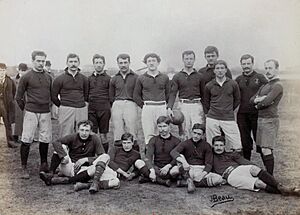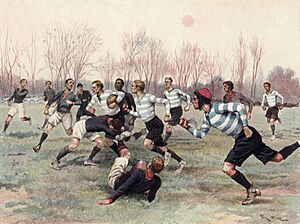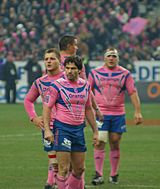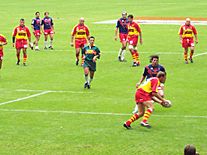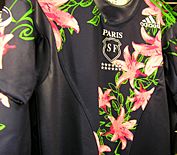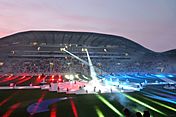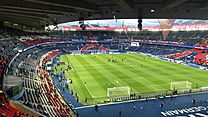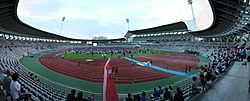Stade Français facts for kids
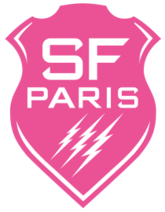 |
||||
| Full name | Stade Français Paris | |||
|---|---|---|---|---|
| Nickname(s) | Les Stadistes Les Soldats Roses (The Pink Soldiers) La Pink Army |
|||
| Founded | 1883 (Stade Français) 1995 (Stade Français CASG) |
|||
| Location | Paris, France | |||
| Ground(s) | Stade Jean-Bouin (Capacity: 20,000) | |||
| Chairman | Hans-Peter Wild | |||
| CEO | Thomas Lombard | |||
| Coach(es) | Paul Gustard | |||
| Captain(s) | Paul Gabrillagues | |||
| Most appearances | Julien Arias (327) | |||
| Top scorer | Diego Domínguez (1,763) | |||
| Most tries | Julien Arias (100) | |||
| League(s) | Top 14 | |||
| 2023–24 | 2nd | |||
|
||||
| Official website | ||||
Stade Français Paris is a famous French professional rugby union club. It is based in Paris, the capital city of France. The team plays in the Top 14, which is the top rugby league in France. Stade Français is known as one of the most successful French rugby clubs in recent times.
The club was first started in 1883. The current team was formed in 1995. This happened when the rugby parts of two clubs, Stade Français and Club Athlétique des Sports Généraux (CASG), joined together.
The team's main home stadium is Stade Jean-Bouin. However, for some big games, they play at the much larger Stade de France. This stadium can hold 80,000 fans. Between 2010 and 2013, the team played at Stade Charléty. This was while a new stadium was being built at the Jean-Bouin site.
Stade Français played in the very first French championship final in 1892. They won many titles in the early 1900s. After a long time in lower leagues, a businessman named Max Guazzini took over in 1992. He helped the team rise quickly back to the top. They won four French championships in just seven years. In 2015, the team won the Top 14 championship again.
Contents
Club History
Stade Français was created in 1883 by a group of students in Paris. On March 20, 1892, the first French rugby union championship was held. It was a single game between Racing Club de France and Stade Français. Racing won that first game.
The next season, Stade Français won against Racing in the final. The team quickly became very strong. They played in almost every championship final until 1899. They won in 1894, 1895, 1897, and 1898.
From 1899 to 1908, Stade Français played in seven championship finals against Stade Bordelais. They won in 1901 and 1908. They also beat SOE Toulouse in 1903. After all this early success, Stade Français did not reach another final until 1927. They lost to Toulouse that year. The club then spent over 50 years in lower rugby divisions.
The Return to the Top
In 1992, while the team was in the third division, businessman Max Guazzini took charge. His goal was to bring top-level rugby back to Paris. In 1995, Stade Français joined with another Paris team, Club Athlétique des Sports Généraux (CASG). This created Stade Français CASG. The team returned to the top division in 1995. This was also when Bernard Laporte became the head coach.
By 1998, the team reached the championship final. They won their first title since 1908, beating Perpignan. Laporte then left to coach the French national team.
European Challenges and More Titles
Under new coaches, Stade Français reached their first Heineken Cup final in 2001. They lost to the Leicester Tigers. The club won the French league again in 2003 and 2004. In the 2004–05 season, they almost won both the French league and the Heineken Cup. But they lost both finals. Fabien Galthié, a former player, became head coach. Stade Français won the 2006–07 championship.
Financial Challenges and New Owners
The club faced money problems in 2011. Max Guazzini sold most of his share in the club. Jean-Pierre Savare, who owned a security company, bought a controlling share. Guazzini stepped down as president.
After six years, Thomas Savare, Jean-Pierre's son, handed over the presidency to Hans-Peter Wild. This happened after a planned merger with rival team Racing 92 was canceled in 2017. Dr. Wild, a Swiss businessman, announced a plan to focus on training young French players.
Fan Support and Stadiums
Max Guazzini wanted to attract more fans to Stade Français games. He tried new ticket prices, like letting women in for free for some matches. He also added fun activities before, during, and after games. These included cheerleaders, music, and a remote-controlled car to bring the kicking tee to players. The club's anthem became "I Will Survive" by Gloria Gaynor.
In 2005, the club introduced a pink jersey. This was a surprising choice for rugby, but it became very popular. Thousands of these jerseys were sold. Guazzini wanted to make rugby popular beyond its traditional fans. He believed the club needed to be creative and reach new audiences.
Stade Jean-Bouin, the team's home stadium, was often too small. So, Guazzini decided to play some big matches at larger venues. In April 2005, they played a European game at Parc des Princes, which was a huge success.
Later, Guazzini decided to use the Stade de France. On October 15, 2005, Stade Français set a world record for attendance at a regular season rugby game. Over 79,500 fans watched them play. They broke this record three more times in the next two years. These games at Stade de France included lots of entertainment, like famous singers, fireworks, and parades.
In 2010, Paris City Hall approved a plan for a new stadium at the Jean-Bouin site. The new 20,000-seat Stade Jean-Bouin opened on August 30, 2013.
New Leadership and Changes
In 2011, the club faced serious financial problems. Thomas Savare became the new president. He invested a lot of money to help the club. Stade Français also started playing some European Challenge Cup matches in other cities like Le Havre and Le Mans.
In March 2017, there was a plan to merge Stade Français with its rival, Racing 92. However, the players strongly opposed this idea and went on strike. Because of this, the merger plan was canceled a few days later.
The Hans-Peter Wild Era
On May 14, 2017, Hans-Peter Wild, a German-Swiss businessman, took over the club. Dr. Wild, who founded Capri-Sun, wanted to develop the club nationally and internationally. He focused on training young French players.
He brought in new coaches and players to strengthen the team. The club also changed its logo to show this new chapter. The new logo kept the pink color, which represents the club's unique and creative spirit. It also added "Paris" to the crest.
Team Name, Logo, and Colors
In the 1880s, many new sports clubs in France used English names. But Stade Français chose "Stade" to remember the ancient Greek stadiums where athletes competed. "Français" (French) was added later.
The club chose the blue, white, and red colors of the French flag. Blue and red are also the colors of the city of Paris. The traditional colors of Stade Français were royal blue jerseys, red shorts, and white socks. The old logo had the letters S and F on a red and blue shield. The twelve blue stars on it represented their twelve championship wins.
The team's current colors are dark blue and pink. The current logo is a blue shield with the letters S and F and three pink lightning bolts.
President Guazzini wanted to create jerseys that stood out. He added three lightning bolts, which are now the club's symbol. In 2005, he introduced the pink away jersey. This was very unusual for rugby, but it became a huge commercial success. The club sold thousands of pink jerseys.
Home Stadiums
The team's main home stadium is Stade Jean-Bouin. It can hold 20,000 people. Before 2011, it was smaller, so the club sometimes played big European games at other stadiums.
The club president, Max Guazzini, decided to play a European quarter-final match at the larger Parc des Princes. This stadium is right across the street from Stade Jean-Bouin. Guazzini also booked the national stadium of France, the 80,000-seat Stade de France, for a Top 14 game. This was very successful, with over 79,500 fans attending. Stade Français broke this attendance record several times.
Stade Français also played some matches at Stade Charléty in Paris. This stadium had a capacity of 20,000, which was larger than Jean-Bouin at the time. In the 2010–11 season, they used Stade Charléty as their regular home while Jean-Bouin was being rebuilt.
Club Image
Max Guazzini, who had a background in media, wanted to make Stade Français a modern and exciting club. He used marketing ideas to promote the team. He wanted to offer a great show to fans. He introduced female cheerleaders, music before games, and fireworks after evening matches. He even used a radio-controlled car to bring the kicking tee to players.
His radio station, NRJ, also sponsored the club. He used his connections in entertainment to bring famous people to games. The club's official anthem was "I Will Survive".
Stade Français has been both praised and criticized for its new ideas. Some traditional rugby fans felt these changes went against the sport's old values. However, others believed it was good for rugby to become more popular and modern.
Main Rivalries
Stade Français does not have one main local rival today. But Racing 92 might become one as they are both Paris-based teams. People in other parts of France often cheer against Paris teams, so Stade Français faces rivalry wherever they play.
Racing 92
Paris was where French rugby union began. Stade Français and Racing Club de France, both from Paris, played the first club match in France in 1891. They were also the only two clubs in the first championship. For many years, the first championships were only played between Paris teams. Racing was seen as a more upper-class club, while Stade was more popular. This rivalry was renewed when Racing Club's new team, Racing Métro, joined the Top 14 in 2009–10.
Bordeaux
Another rivalry developed with Stade Bordelais when clubs from outside Paris were allowed to play in 1899. These two teams met in seven of the next ten finals. Bordeaux won five of them. One of the most intense matches was in 1901, when Stade Français won after a dispute over ineligible players. The French rugby union ordered a replay, but Bordeaux refused. So, Stade Français was declared the winner.
Toulouse
Today, Stade Français also has big rivalries with other top teams like Toulouse and Biarritz Olympique. Stade Français was seen as a threat to the powerful Toulouse team, who had won many titles. The clubs have often competed for top spots. In 2003, Stade Français beat Toulouse in a final. Toulouse got their revenge in 2005, winning a close Heineken Cup final in extra time. Many players from both clubs also played together for the French national team.
Biarritz
Games between Stade Français and Biarritz are also very competitive. Biarritz became a strong team in 2002. In April 2005, Stade's victory in a Heineken Cup semi-final created a lot of tension. A month later, the two clubs played in the Top 14 final, which was very physical. Biarritz won in extra time.
Five months later, they met again, and a huge fight broke out early in the game. The referee gave out yellow and red cards to players. The rest of the match was very rough. Both teams blamed each other after the game. Since then, matches between them have been calmer.
Club Achievements
- French championship Top 14
- Champions (14): 1893, 1894, 1895, 1897, 1898, 1901, 1903, 1908, 1998, 2000, 2003, 2004, 2007, 2015
- Runners-up (9): 1892, 1896, 1899, 1904, 1905, 1906, 1907, 1927, 2005
- Heineken Cup / European Rugby Champions Cup
- Runners-up (2): 2001, 2005
- European Rugby Challenge Cup
- Champions (1): 2017
- Runners-up (2): 2011, 2013
- French Cup
- Champions (1): 1999
- Runners-up (1): 1998
- Coupe de l'Espérance
- Runners-up (1): 1916
Finals Results
Heineken Cup and European Rugby Champions Cup
| Date | Winners | Score | Runners-up | Venue | Spectators |
| May 19, 2001 | 34–30 | Parc des Princes, Paris | 44,000 | ||
| May 22, 2005 | 18–12 | Murrayfield Stadium, Edinburgh | 51,326 |
European Rugby Challenge Cup
| Date | Winners | Score | Runners-up | Venue | Spectators |
| May 20, 2011 | 19–18 | Cardiff City Stadium, Cardiff | 12,236 | ||
| May 17, 2013 | 34–13 | RDS Arena, Dublin | 20,396 | ||
| May 12, 2017 | 25–17 | Murrayfield Stadium, Edinburgh | 24,494 |
Current Team Standings
2024–25 Top 14 season
Current Squad
The Stade Français team for the 2024–25 season includes:
Note: Flags indicate national union as has been defined under WR eligibility rules. Players may hold more than one non-WR nationality.
Espoirs Squad
This is the youth development squad for Stade Français:
Note: Flags indicate national union as has been defined under WR eligibility rules. Players may hold more than one non-WR nationality.
|
|
Famous Former Players
 Alexandre Albouy
Alexandre Albouy Géo André
Géo André Benoît August
Benoît August David Auradou
David Auradou Édouard Bader
Édouard Bader Mathieu Bastareaud
Mathieu Bastareaud Lionel Beauxis
Lionel Beauxis Nicolas Bézy
Nicolas Bézy Mathieu Blin
Mathieu Blin Hugo Bonneval
Hugo Bonneval Fernand Bouisson
Fernand Bouisson Guillaume Boussès
Guillaume Boussès Olivier Brouzet
Olivier Brouzet Jacques Chaban-Delmas
Jacques Chaban-Delmas Denis Charvet
Denis Charvet Jean Chastanié
Jean Chastanié Arthur Chollon
Arthur Chollon Franck Comba
Franck Comba Marcel Communeau
Marcel Communeau Christophe Dominici
Christophe Dominici Geoffrey Doumayrou
Geoffrey Doumayrou Julien Dupuy
Julien Dupuy Pierre Failliot
Pierre Failliot Jerome Fillol
Jerome Fillol Fabien Galthié
Fabien Galthié Roland Garros
Roland Garros Pierre Gaudermen
Pierre Gaudermen Jean-Guy Gautier
Jean-Guy Gautier Philippe Gimbert
Philippe Gimbert Auguste Giroux
Auguste Giroux Stéphane Glas
Stéphane Glas Arthur Gomes
Arthur Gomes Adolphe Jauréguy
Adolphe Jauréguy Nicolas Jeanjean
Nicolas Jeanjean Christophe Juillet
Christophe Juillet Benjamin Kayser
Benjamin Kayser Jean-Baptiste Lafond
Jean-Baptiste Lafond Raphaël Lakafia
Raphaël Lakafia Fabrice Landreau
Fabrice Landreau Christophe Laussucq
Christophe Laussucq Marcel Legrain
Marcel Legrain Émile Lesieur
Émile Lesieur Robert Levasseur
Robert Levasseur Brian Liebenberg
Brian Liebenberg Marc Lièvremont
Marc Lièvremont Thomas Lombard
Thomas Lombard Arnaud Marchois
Arnaud Marchois Sylvain Marconnet
Sylvain Marconnet Rémy Martin
Rémy Martin Geoffroy Messina
Geoffroy Messina Olivier Milloud
Olivier Milloud Christophe Moni
Christophe Moni Vincent Moscato
Vincent Moscato Joseph Olivier
Joseph Olivier Raoul Paoli
Raoul Paoli Pascal Papé
Pascal Papé Alain Penaud
Alain Penaud Pierre Rabadan
Pierre Rabadan Olivier Roumat
Olivier Roumat Julien Saubade
Julien Saubade Serge Simon
Serge Simon Jeremy Sinzelle
Jeremy Sinzelle David Skrela
David Skrela Rabah Slimani
Rabah Slimani Dimitri Szarzewski
Dimitri Szarzewski Patrick Tabacco
Patrick Tabacco Jean Vaysse
Jean Vaysse Pierre Vigouroux
Pierre Vigouroux Pieter de Villiers
Pieter de Villiers
International Players
 Nahuel Tetaz Chaparro
Nahuel Tetaz Chaparro Felipe Contepomi
Felipe Contepomi Ignacio Corleto
Ignacio Corleto Juan Martín Hernández
Juan Martín Hernández Juan Manuel Leguizamón
Juan Manuel Leguizamón Agustín Pichot
Agustín Pichot Gonzalo Quesada
Gonzalo Quesada Martín Rodríguez
Martín Rodríguez Rodrigo Roncero
Rodrigo Roncero Gonzalo Tiesi
Gonzalo Tiesi
 Patricio Noriega
Patricio Noriega Francis Fainifo
Francis Fainifo Mark Gasnier
Mark Gasnier Will Genia
Will Genia Digby Ioane
Digby Ioane Richard Kingi
Richard Kingi David Lyons
David Lyons Radike Samo
Radike Samo George Smith
George Smith Morgan Turinui
Morgan Turinui Paul Warwick
Paul Warwick Paulo do Rio Branco
Paulo do Rio Branco Robins Tchale-Watchou
Robins Tchale-Watchou Mike James
Mike James Morgan Williams
Morgan Williams Stan Wright
Stan Wright James Haskell
James Haskell Tom Palmer
Tom Palmer Ollie Phillips
Ollie Phillips Richard Pool-Jones
Richard Pool-Jones Paul Sackey
Paul Sackey Alex Rokobaro
Alex Rokobaro Davit Kubriashvili
Davit Kubriashvili Zurab Zhvania
Zurab Zhvania Constantin Henriquez
Constantin Henriquez Mauro Bergamasco
Mauro Bergamasco Mirco Bergamasco
Mirco Bergamasco Sergio Parisse
Sergio Parisse
 Diego Domínguez
Diego Domínguez John Akurangi
John Akurangi Byron Kelleher
Byron Kelleher Regan King
Regan King Nae Mărăscu
Nae Mărăscu Constantin Cratunescu
Constantin Cratunescu Teodorin Tudose
Teodorin Tudose Brian Lima
Brian Lima Gavin Williams
Gavin Williams Krisnan Inu
Krisnan Inu Hugo Southwell
Hugo Southwell Simon Taylor
Simon Taylor Falie Oelschig
Falie Oelschig Jono Ross
Jono Ross Shaun Sowerby
Shaun Sowerby Pablo Lemoine
Pablo Lemoine Scott LaValla
Scott LaValla
Head Coaches
 Bernard Laporte (1995 – 1999)
Bernard Laporte (1995 – 1999) Georges Coste (1999 – 2000)
Georges Coste (1999 – 2000) John Connolly (2000 – 2002)
John Connolly (2000 – 2002) Nick Mallett (2002 – 2004)
Nick Mallett (2002 – 2004) Fabien Galthié (2004 – 2008)
Fabien Galthié (2004 – 2008) Ewen McKenzie (2008 – 2009)
Ewen McKenzie (2008 – 2009) Jacques Delmas (2009 – 2010)
Jacques Delmas (2009 – 2010) Didier Faugeron (2009 – 2010)
Didier Faugeron (2009 – 2010) Michael Cheika (2010 – 2012)
Michael Cheika (2010 – 2012) Richard Pool-Jones (2012 – 2013)
Richard Pool-Jones (2012 – 2013) Gonzalo Quesada (2013 – 2017)
Gonzalo Quesada (2013 – 2017) Greg Cooper (2017 – 2018)
Greg Cooper (2017 – 2018) Heyneke Meyer (2018 – 2020)
Heyneke Meyer (2018 – 2020) Gonzalo Quesada (2020 – 2023)
Gonzalo Quesada (2020 – 2023)
See also
 In Spanish: Stade Français Paris para niños
In Spanish: Stade Français Paris para niños
- List of rugby union clubs in France
- Rugby union in France


